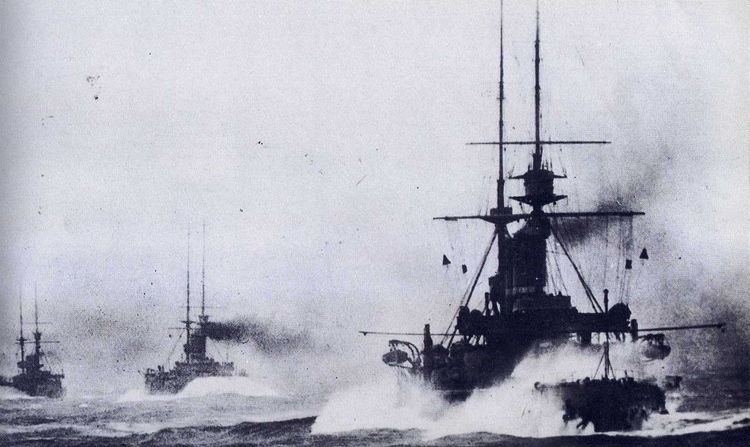Active 1913–1945 Branch Royal Navy | Country United Kingdom Size Squadron | |
 | ||
The British Royal Navy 3rd Battle Squadron was a naval squadron consisting of battleships and other vessels, active from at least 1914 to 1945. The 3rd Battle Squadron was initially part of the Royal Navy's Home Fleet. During the First World War, the Home Fleet was renamed the Grand Fleet. During the Second World War, the squadron covered Atlantic convoys.
Contents
First World War
On 5 August 1914, the squadron had eight ships: King Edward VII, Africa, Britannia, Commonwealth, Dominion, Hibernia, Hindustan and Zealandia. The squadron of eight King Edward VII-class pre-dreadnought battleships were nicknamed "the wobbly eight" after their slight tendency to roll under way.
The squadron was initially used as part of the Grand Fleet in support of the cruisers on the Northern Patrol. On 29 April 1916, the 3rd Battle Squadron was moved to Sheerness from Rosyth and came under the Nore Command in the Thames estuary. The move was intended to make more large ships available for coastal defence duties, after the Bombardment of Yarmouth and Lowestoft by German ships on 24 April 1916.
At the time of the Battle of Jutland, the squadron consisted of: Dreadnought (flagship of Vice-Admiral E. E. Bradford), Africa, Commonwealth, Hibernia, Dominion, Hindustan, Zealandia and Britannia, plus the repeating cruiser Diamond. In addition the 3rd Cruiser Squadron, consisting of the armoured cruisers Antrim, Devonshire and Roxburgh, was attached, together with the destroyers Beaver, Druid, Ferret, Hind, Hornet and Sandfly from the 1st Destroyer Flotilla, and Mastiff and Matchless from the 10th Destroyer Flotilla.
Essentially made obsolete by the introduction of the revolutionary battleship Dreadnought, and as battleships the world over began mimicking her design, the 3rd Battle Squadron played no role in the Battle of Jutland. The need for accompanying destroyers for these battleships was later given as the reason the Harwich destroyer squadron was also held back and took no part in the Jutland action.
Following the loss of King Edward VII in January 1916, Africa and Britannia served in the Mediterranean 1916–17. The remaining ships were augmented by Dreadnought until March 1918.
The squadron was disbanded on 20 April 1918.
Second World War
At the start of the Second World War, the squadron formed part of the Channel Force and comprised just two ships:
Later in the war, the squadron was based at Halifax, Nova Scotia. Rear Admiral, Third Battle Squadron, was responsible for covering Atlantic convoys. RMS Ascania—an armed merchant cruiser—was part of the squadron during this period. Seaborn—a Fleet Air Arm base was established at RCAF Station Dartmouth in September 1940. Seaborn was to provide a shore base with administrative and maintenance facilities for the Swordfish and Walrus aircraft assigned to ships of the Third Battle Squadron.
In 1942, the Third Battle Squadron, now comprising;
sailed for the Far East and became part of the Eastern Fleet. The squadron formed part of Force B. Facing the superior striking force of the Japanese Kido Butai carrier striking force during the 1942 Indian Ocean raid, the slow component of the Eastern Fleet—including the battleships of Force B—was withdrawn all the way back to Kilindini in East Africa to avoid their destruction at Japanese hands. Hermes—Force B's sole aircraft carrier—was detached and destroyed near Ceylon.
In 1945, the Squadron consisted of two battleships, Queen Elizabeth and the Free French Richelieu, as well another two escort carriers, four cruisers and six destroyers. Two battleships and escort carriers formed part of the covering force for Operation Dracula, the retaking of Rangoon. Vice-Admiral H.T.C. Walker commanded the squadron at the time.
Commanders
Commanders were as follows:
